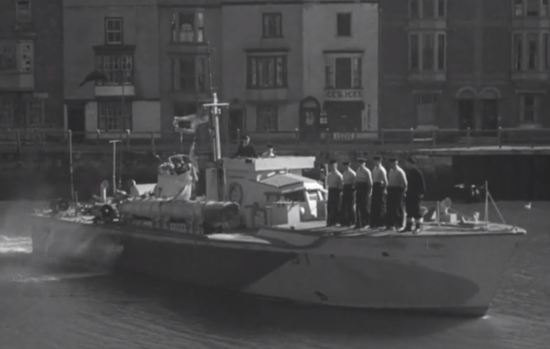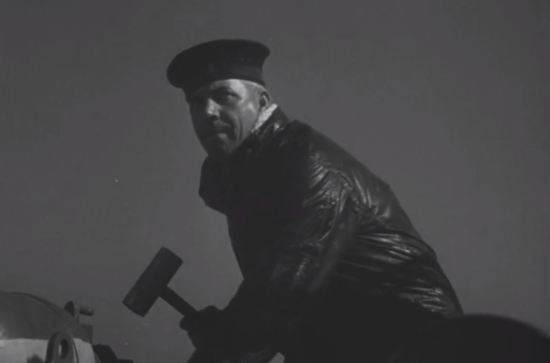The Broad Fourteens is far more than a thirty minute film, it’s an incredibly important historical record of the work of Coastal Forces during the war and required watching for anyone who has even the slightest bit of interest in MTBs and MGBs.
The wartime film is typical of the period it was made in. Produced by the Crown Film Unit for the Ministry of Information, it is meant to provide entertainment for the cinema going public, whilst at the same time educating them about the role of Coastal Forces and the conduct of the war. Directed by R. McNaughton, the film was shot between 1943 and 1944, passed by the Admiralty censor in December 1944, and the finished film was delivered on the 22nd March 1945. It was certificated in April and registered for the (now defunct) screen quota system on the 18th May 1945. This was, of course, just after the war in Europe had ended and this is perhaps why the film does not seem to have gone into general release, perhaps only being shown at a trade show in July and at a press show in August.1
The film is set at the fictional HMS Terrier Coastal Forces base on the east coast, with patrols foraying into the North Sea and the eponymous Broad Fourteens area of sea off the Dutch coast. After working up, a young lieutenant and his crew undertake numerous patrols, never seeming to find the enemy until, whilst intercepting a convoy, finally seeing combat. The plot is simple and the script uncomplicated (it’s only fourteen pages long1), but this is part of its charm.

HMS Terrier is clearly actually HMS Bee, the Coastal Forces working up base at Weymouth.Note 1 The identity of the crew is unknown, although they quite possibly are, as the film claims in the opening credits, genuine Royal Navy crewmen. Using genuine servicemen instead of actors is not as unlikely as it seems – the 1946 release Theirs is the Glory, depicting the Battle of Arnhem and shot in location in 1945 only a year after the events it covers, almost exclusively uses actual veterans of the battle.2
MTB 205, built by Whites of Cowes to a Vosper design is seen in Weymouth, along with what may be sister vessel MTB 210.Note 2 MTB 354 is also seen in the film, operating at sea in what are almost certainly genuine manoeuvres recorded for the film. At least three early 70ft British Power Boat Company Motor Gun Boats can also be seen at the end of the film.
The main star of the film is the fictional MTB 181 (no such boat was ever commissioned), which Coastal Forces historian Geoffrey Hudson believes to be MTB 352.3 However, approximately five minutes into the film when 181 arrives in Weymouth, 352 can be seen alongside the harbour wall from the deck of 181. It’s possible that the two angles were filmed at different times, that the deck of the arriving boat was a different MTB and that 352 was later repainted as 181 to shoot the arrival scene from different angles, but this seems somewhat unlikely.
Assuming any of the boat identities are genuine, MTB 352, built by Vosper at their Wivenhoe yard, was delivered to the Royal Navy on the 31st May 1943.4 She was recorded in service with the 11th MTB Flotilla on the east coast before the end of the year, but was sunk in the North Sea after a collision on the 26th March 1944.5 This places the filming of the harbour scenes between those dates, although the dense foliage visible on the trees around the Nothe suggests it was sometime in the summer or autumn of 1943. 352’s presence suggests it may be during her own working up period at Bee, most likely in June and early July 1943.
MTB 354 was also built at Wivenhoe and commissioned in late September 1943.4 She may have been filmed in the first two weeks of October during her working up and before HMS Bee transferred to Holyhead on the 16th October 1943. Equally her scenes may have been filmed with other boats of the 5th MTB Flotilla (of which she was a part) at a later time.5
The true importance of The Broad Fourteens can be seen when it’s compared to more fanciful films like Hell Boats. The film is a far more accurate account of warfare in Coastal Forces and the conditions on board an MTB. The seemingly endless lengthy nights of patrols with no sign of the enemy are a feature of many Coastal Forces memoirs, as is the suddenness of an action. The mission that sees the crew finally engage the enemy is not an absurdly contrived plot (such as Hell Boats‘ finale), but a normal, almost routine, interception of an enemy coastal convoy. Small details such as the use of the torpedo firing sight, the engine room crew communicating through sign language and the man stood on deck with a hammer (he’s actually there to activate the torpedo tube should the firing lever on the bridge not work) add to the genuineness of the film and are the sort of details a modern film would probably miss.

Even other, seemingly random, events depicted in the film have a historical basis. 181’s discovery of two beer barrels that they manage to navigate to on their return journey, is based on an experience Peter Dickens had in March 1943. When investigating apparent mines, his crew found two barrels of Guinness. Knowing the hindrance they would add to an already crowded deck during action, Dickens reluctantly ordered them to be left. But his navigator was able to fix their location and the following morning, even in fog, the crew were able to recover their prize. Dickens makes no mention of Customs men, or even of informing them…6
Had The Broad Fourteens been released earlier in the war it might conceivably have become better known and be more readily available today. Fortunately it was selected for preservation by the Imperial War Museum in 1967, noting that it was not in in the British Film Institute’s listings.1 A higher resolution version of the film, shown in four parts, is available on the Imperial War Museum’s website.
Notes
- HMS Bee, the working up base where crews trained on new boats prior to operations, was technically based at Weymouth from September 1942 to October 1943, before it moved to Holyhead and Weymouth became the active base HMS Grasshopper. However, some memoirs appear to recall conducting working up exercises in Weymouth well into 1944.
- The final digit of this boat is hard to discern. It may be 210 or could possibly be 216 or 218. If it is either of these two, it cannot be a genuine number. 216 was a Thornycroft boat and 218 was sunk in August 1942.
References
- Crown Film Unit, 1945. The Broad Fourteens: Notice of completion of a Crown Copyright Film. Held in The National Archives.
- ParaData. Theirs is the Glory. Accessed June 2018.
- Imperial War Museums Collections. The Broad Fourteens. Accessed June 2018.
- John Lambert & Al Ross, 1993. Allied Coastal Forces of World War II Volume 2: Vosper MTBs & US ELCOs. Conway Maritime Press. p.122
- Leonard Reynolds, 2000. Home Waters MTBs & MGBs at War. Sutton Publishing. pp190-194
- Peter Dickens, 1974. Night Action. Seaforth Publishing. pp.162-165
© Spitfires of the Sea

